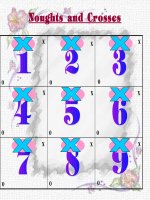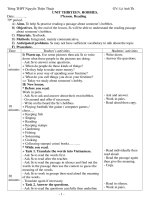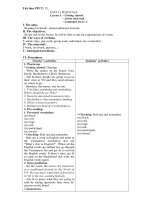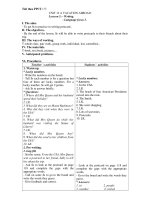unit 13 ( moi)
Bạn đang xem bản rút gọn của tài liệu. Xem và tải ngay bản đầy đủ của tài liệu tại đây (99.7 KB, 13 trang )
Date of preparing:
Period:
Class
10a1 10a5 10a6 10a7
Date of teaching
Total
Student s adsent
UNIT 13: FILMS AND CINEMA
LESSON 1: READING
I. Objectives:
1. Education aims: - Students know more about the history of films.
2. Knowledge:
a. General knowledge: - Knowledge about films and cinema.
b. Language: - The past simple tense.
- Vocabulary concerning music: scene, camera,
character
3. Skills: - Speaking : talk in pairs and in groups.
- Reading comprehension: better sts' reading skill through finding the
word meanings in contexts, answering questions and identifying the main idea.
II. Anticipated problems:
- Students may not have much knowledge and words/phrases about films and
cinema.
III. Teaching aids: board, textbook, chalk, some pictures.
IV. Procedures:
Teachers activities Students activities
1. Warm-up:(5 mins)
- Show sts some pictures of famous film stars
or scenes in famous films in Vietnam amd in
the world.
- Ask sts to say the names of these films and
film stars.
- Get feedback and check.
2. Before you read:( 12 mins)
Aims: To introduce the topic and provide sts
with words/phrases about films and cinema.
a. Answering questions:
- Ask sts to work in pairs to ask and answer
the questions in Before you read.
- Go round to help if necessary.
- Ask some sts to give answers.
- Listen and check. Sts may give different
answers. b.Vocabulary.
- Provide sts with the new words/phrases:
+ 'sequence (n):chuỗi
+ motion (n): sự vận động
+ movement (n):sự chuyển động
+ 'decade (n): 10 years
+ au'dience (n):khán giả
+ spread (v): lan rộng
- Read each word/phrase 3 times and ask sts
- Look at the T's pictures .
- Stand up and say aloud the names
of the films and film stars.
- Work in pairs to ask and answer.
- Give answers orally.
1. I want to see a film on T.V
because it is cheap and I may feel
more comfortable.
- I want to see a film at the
cinema because I can see the latest
film there.
- Others listen
- Listen and read after the T.
- Write down these words into their
notebooks.
to repeat it.
- Leave sts 1 minute to self-practice.
- Ask 4-5 sts to read all the word/phrases
aloud in front of the class( 1 st/ 1 time)
- Listen and help sts to read the words/phrases
correctly.
3. While you read:( 18 min)
Aims: Read for information to find the word
meaning in contexts, to answer the questions
and to find the best title for the passage.
+ Task 1: Finding the words in the passage
- Ask sts to read the passage indepently then
read the definition given in task 1 and scan
the passage to find the suitable words.
- Tell sts to refer to Vocabulary for help and
encourage them try to guess the meanings of
the words in contexts of the reading.
- Ask sts to share their answers with their
partners.
- Call on 6 sts to read their answers aloud in
front of the class.
- Get feedback and give remarks.
+ Task 2: Answering questions.
- Ask sts to work in pairs to read the passage
more carefully and find the answers to the
questions given.
- Ask sts to highlight or underline the
information in the passage that helps them to
find the correct answers.
- Move round to help is necessary.
- 6 pairs are required to give answers in front
of the class.
- Listen and help the students to give correct
answers.
+ Task 3:
- Ask sts to read the passage again
individually and choose the best title for the
passage.
- Ask one or two sts to give answer and to
explain why they choose A, B or C.
- Listen and check.
4 . After you read:( 9 mins)
Aims: Students' summary about the history of
cinema.
- Ask sts to look at the cues given and work
in groups to talk about the history of cinema
basing on the cues.
- Go round to help sts with their work.
- Some presentatives of the groups are
required to report in front of the class.
- Listen and help sts to give correct answers.
5. Homework:( 1 min)
- Listen and repeat.
- Read these words and check for
their partner.
- Read the words aloud.
- Listen to the T.
- Work individually.
- Report their answers one by one.
1. cinema 2. sequence
3. a decade 4. rapidly
5. scene 6. character
- Listen to the T
- Students do the work in pairs
- Some pairs report their answers
while others watch.
1. It began in the early 19
th
century.
2. They dicovered that when a
sequence of still pictures were set in
motion
3. No, they didn't.
4. Audiences were able to see long
films in the early 1910s.
- Self-correct the work
- Read the passage again and choose
the best title.
Answer: B ( A brief history only)
- Listen to their friends and the T.
- Work in groups orally.
- Some sts report.
- Listen to the T.
- Write a summary of the reading text basing
on what they have discussed in After you
read.
V . Comments.
……………………………………………………………………………………………………………………
…………………………………………………………
Date of preparing:
Period:
Class
10a1 10a5 10a6 10a7
Date of teaching
Total
Student s’ adsent
LESSON 2: SPEAKING
I. Objectives:
1. Education aims: - Students know about some kinds of film.
2. Knowledge:
a. General knowledge: - Students can talk about some favourite kinds of
music.
b. Language: - The simple present tense.
- Vocabulary to describe films.
3. Skills: - Asking and answering questions about film.
- Talking about favourite kinds of music.
- Expressing attitudes, preferences
II. Anticipated problems:
Sts might not have enough vocabulary to talk about the topic. They might
also have difficulty in using the structure find + O+ Adj and confuse adjs with
ending in ing– with those ending in -ed
.Sts may not have enough vocabulary to talk about the topic.
III. Teaching aids:
Textbook, chalk, board, pictures.
IV. Procedures:
Teacher’s activities Students’
activities
1. Warm- up: ( 5 minutes )
Aims : to get used to the topic.
- Give sts some film posters on the board:
+ Names of the films:
Shrek (1)
The adventures of Sherlock Holmes. (2)
The Lord of the Rings (3)
Pearl Habour ( 4)
- Ask sts to match the films with the correct
types of films .
- Listen and check.
2. Before you speak:( 8 minutes)
Aims: :to focus sts on the topic and to
introduce the words and phrases used in the
task.
+ Task 1:
- Ask sts to study the table on p. 134 and tick
the boxes that suit their preferences for a
particular type of films.
- Ask sts to compare their answers with a
partner.
- Call on some sts to report their likes and
dislikes.
- Listen and give remarks.
3.While you speak: ( 20 minutes )
Aims: Sts can talk about their favourite type
of films
+ Task 2: Find out what your friends feel
about each kind of films.
- Give sts some new words:
+ violent (adj): b¹o lùc
+ horrifying (adj) lµm khiÕp sî
+ moving (adj): c¶m ®éng
+ find + O + Adj
- Ask sts to read the new words orally and
individually
- Introduce sts some expressions of agreement
and disagreement.
+ Agreement: + Disagreement:
I agree I don't think so.
Yes, exactly Yes, but
Right / Sure ! I don't quite agree
with you.
- Ask some sts to read the model conversation
in the textbook.
- Divide the class into small groups of 3 and
- Look at the posters and match the
film with the correct types.
- Some sts give the answers.
+ Key:
1- cartoon 2- detective film
3- action film 4- war film
- Look at the table and tick .
- Compare with their partner’s.
- Some sts report:
S1: I like science fiction films very
much.
S2: I don't like cartoons very much.
S3: I don't like horror films at all.
- Listen and take notes
- Read the new words orally and
individually.
- Listen to the T.
- Read the model aloud.
- Work in groups and ask some sts
to present.
A: What do yoy think of detective
films?
B: Oh, I find them exciting.
ask sts to find out what the others of their
group feel about the given types of films.
- Go around to help sts if necessary .
- Call on some groups to practise the
dialogues.
- Listen and give remarks.
+ Task 3: Find out the preferences of your
friend for films.
- Introduce the structure “ prefer st to st“ ,
which can be used to talk about one’s
preferences.
- Ask sts to make sentences with the structure.
- Call on two sts to read the model
conversation in the textbook.
- Ask sts to work in pairs and find out about
their partner’s preference for a particular type
of films, basing on the model conversation.
- Go around to offer help.
- Ask some pairs to practise the dialogues.
- Listen and correct their mistakes.
4. After you speak: (10 min )
Aims: Sts can talk about the film they have
seen.
+ Task 4: Talk about a film you have seen.
- Ask sts to work in groups to ask and answer
about a film they have seen using the
suggestions given in the textbook.
- Ask sts to take turns to talk about the films
they have seen.
- Go around to help sts.
- Ask some sts present in front of the class if
the permits
5. Homework: ( 2 min )
- Write a short paragraph about a film they
have already said about.
C: I think so. I think they are good
fun.
- Listen to the T
- Make sentences with the structure.
- Two sts read the model
conversation.
- Work in pairs to ask and answer
the similar questions.
S1: Which do you prefer, thrillers or
science fiction films?
S2: Well, I suppose I prefer science
fiction films to thrillers.
- Listen to the T.
- Work in groups.
- Some sts report in front of the
class.
E.g: I saw " Sand life" at the
cinema. It is a love story film. It is
about the life of a soldier after the
war. He has already been married
but after the war he returns with
another woman. Life with two wives
is definitely not easy. I feel sorry for
the soldiers' life after the war. I like
the film because of its humane
value.
V . Comments.
……………………………………………………………………………………………………………………
…………………………………………………………
Date of preparing:
Period:
Class
10a1 10a5 10a6 10a7
Date of teaching
Total
Student s’ adsent
LESSON 3: LISTENING
I. Objectives:
1. General knowledge:
- Sts know how some people can arrange to do st.
2. Language: - Vocabulary on days of the week .
3. Skills: - Listening: Listen for the main idea and fill in the chart .
- Speaking: Talk about sb's plans.
II. Anticipated problems:
- Sts may not interested in "The Titanic" as it is an old film.
III. Teaching aids:
- Tape, cassette player, textbook, chalk, board.
IV. Procedures:
Teacher’s activities Students’ activities
1. Homework checking:(7 mins)
-Ask one sts to talk about a film he likes best.
- Listen and give remarks.
2. Before you listen:(12 mins)
Aims:to focus sts on the topic and to review/
introduce the words and phrases used in the
listening text.
a. Ask sts to work in groups and list the types of
entertainments.
- Note down the list on board:
go to the cinema/ watch TV
listen to music/
- Ask sts to read the table in the book and put a
tick on the right column.
- Compare their answers with a partner.
- Ask some sts to speak aloud.
b. Introduce some new words
- ti'tanic (adj): great, huge (The name of a
film)
- su'ppose(v): think that st is true but not be
- One st presents.
- Others listen and give remarks.
- Listen to the T.
- Work in groups to list the
entertainments
- Stand up and give their
answers.
S1: I never go to the cinema.
S2: I often watch T.V.
S3: I sometimes listen to the
radio.
- Listen to their friends.
- Copy the words and phrases.
sure
- guess(v): predict, give an answer but do not
know if it is right
- instead (adv): in the place of st/ sb
- Read the words asks sts to repeat.
- Ask sts to read the words in pairs.
- Ask some sts to read the words again
3. While you listen:( 17 mins)
+ Task 1:
Aims: Sts practise listening and marking True/
False statements.
- Tell sts that they are going to listen to a
conversation between two friends, Lan and
Huong.
- Ask sts to work in pairs, look at the picture and
guess what the conversation is about.
- Ask sts to listen to the talk and answer the
question: "What are they planning to do?". T
plays the tape once.
- Ask sts to exchange their answer in pairs.
- Check sts’ answer.
- Play the tape once again and conduct the
correction.
+ Task 2:
Aims: to practise listening for specific
information by fillingin a chart.
-Ask sts to have a look at the chart in pairs and
make sure they know what information they need
to fill in the blanks.
- Ask sts to listen to the tape once/twice and take
short notes to fill in the chart.
- Ask sts to compare their answer in pairs.
- Play the tape once again, stop the tape where
necessary and conduct the correction.
- Ask sts to look at the chart again and find out if
there is a day when both Lan and Huong are free
to go to the cinema together.
4. After you listen:(8 mins)
- Ask sts to work in pairs and use the chart to talk
about Lan and Huong's plan for nextweek
- Revise some structures to show one's plans:
- be going to V
- be Ving
- Move round to check the activities and to make
sure that sts are working effectively.
- Ask some sts to present in front of the whole
class.
- Listen and repeat.
- Read the words in pairs and
correct each other’s mistakes.
- Some sts read the words aloud.
- Listen to the T.
-Work in pairs to guess what the
conversation is about.
-Listen to the tape and do the
task
- Exchange their answer.
- Gives their answer.
They are planning to go to the
cinema together to see Titanic
- Check their answer and then
correct their work if necessary.
- Work in pairs to have a look at
the chart.
- Listen and do the task.
- Compare their notes.
Lan
Mon
see a play
Tue
Wed
Thu visit grandparents
Fri
Sat work (busy)
Sun
Key: Tuesday
- Check their answer, and then
correct their work if necessary.
- Study the chart and find out a
day when both of the girls can go
to the cinema. Sts give their
answer.
- Work in pairs talking about the
two people' plans
- Some sts present.
- Check and gives remarks.
5. Homework:(1 min)
Write a short paragraph about your plan for next
week.
V . Comments.
……………………………………………………………………………………………………………………
…………………………………………………………
Date of preparing:
Period:
Class
10a1 10a5 10a6 10a7
Date of teaching
Total
Student s’ adsent
LESSON 4: WRITING
I. Objectives:
1. Education Aims: - Students can write a description of a film.
2. Knowledge:
a. General knowledge: - The film Titanic.
b. Language: - Language used to describe a film.
- The present tenses .
3. Skills: - Reading: read the description of the film Titanic and then answer the
questions.
- Writing: write about a film they have seen.
II. Anticipated problems:
- Students may find it difficult to write about the content of the film.
III. Teaching Aids: - board, textbook, chalk.
IV. Procedures:
Teacher's activities Students' activities
1. Homework checking :( 5 mins)
- Ask one st to talk about Lan and Huong's
plans for the next week.
- Ask other sts to listen to their friend and
give remarks.
- Check and give remarks.
2. Before you write:( 20 mins)
- Aims: to get sts to recognise how to
describe a film and to read the information
about the film Titanic.
+ Task 1:
- Introduce the topic of the lesson: describing
a film.
- Introduce some new words:
+'tragic (a): bi th¶m
+'luxury (n) : sù xa hoa
+'voyage (n): a long journey by sea
+ ad'venturer (v) : ngêi thÝch phiªu lu.
+ be engaged: ®Ýnh h«n
+ 'iceberg (n): t¶ng b¨ng tr«i
- Ask sts to listen and repeat and then copy
down these words into their notebooks.
- Ask some sts to read these words again.
- Ask sts to read the description of the film
Titanic in task 1 and to answer the questions
about the film.
- Allow sts to work in pairs to ask and answer
the questions orally.
- Move around to help if necessary.
- Ask sts to compare their answer with other
pairs.
- Get feedback and give remarks.
+ Task 2:
- Ask sts to think of a film they have already
seen and then work in pairs to ask and answer
similar questions to those in task 1.
- Allow sts to work in pairs in 5 minutes.
- Move around to help if necessary and to
check .
- Listen to their friend and give
remarks.
- Listen to the teacher.
- Listen to the teacher carefully.
- Copy down the words into theit
notebooks.
- Listen and repeat.
- Some sts stand up and read again.
- Read the description of the film
Titanic in task 1 and to answer the
questions about the film.
- Work in pairs to ask and answer
and then share their answer with
their friends.
- Present their ideas.
1. The name of the film is Titanic.
2. It is a tragic love story film.
3. It is about the sinking of a luxury
liner.
4. It is made in America.
5. It is based on the true story of
Titanic.
6. The main character are Jack
Dawson and Rose DeWitt Bukater.
7. Jack is a young and generous
adventurer. Jack and Rose fall in
love with each other.
8. It has a sad ending.
- Listen to the teacher.
- Think of a film that they have
seen.
- Work in pairs to ask and answer
- Correct sts' mistakes if there are any.
3. While you write:( 10 mins)
- Aims: Sts practise writing a description of a
film they have seen basing on the answers
- Ask sts to write down what they have
discussed into their notebooks.
- Let sts write in 10 minutes.
- Ask them to refer to the model description in
task 1 if necessary.
- Move around to conduct the activity.
4. After you write:( 9 mins)
Aims: to get feedback and check sts' work.
- Get feedback by asking some sts to read
their work aloud.
- Ask some other sts to give remarks.
- Check and give the correct answer.
- If there is enough time, T can have sts
exchange their writing among sts within a
group so that they can check their friend's
work and give remarks.
5. Homework: ( 1min)
- Part D (page 79 - workbook).
about the films they have seen.
- Listen to the teacher.
- Do the writing task.
- Read their writing: ( a sample
paragraph)
" Of all the films I have seen, "
Gone with the wind" is the film I
like best. " Gone with the wind" is a
love story film. It is about the
change in a woman 's life during
the civil war
in America. The film is made in
America. It is based on the famous
novel " Gone with the wind" written
by Margaret Mitchell. The main
character is Scallet O'hara. She is a
beautiful but ambitious woman "
V . Comments.
……………………………………………………………………………………………………………………
…………………………………………………………
Date of preparing:
Period:
Class
10a1 10a5 10a6 10a7
Date of teaching
Total
Student s’ adsent
LESSON 5: LANGUAGE FOCUS
I. Objectives:
1. Education Aims:- Students know how to pronounce the sound /f/ and /v/
correctly.
- Students learn about: - Adjectives of attitude.
- Structure: It is/was not until that
- Articles: a/an and the
2. Knowledge:
+ Language: - Pronunciation: /f/ and/v/ .
- Adjectives of attitude.
- Structure: It is/was not until that
- Articles: a/an and the
3. Skills: + Speaking: - Work in pairs to discuss the exercises.
+ Reading: - Read words and sentences aloud.
- Read the sentences silently to do the exercises.
II. Anticipated problems:
- Students may find it difficult to distinguish adjectives ending in -ing from
adjectives ending in -ed.
III. Teaching aids: - board, chalk, textbook.
IV. Procedures:
Teacher's activities Students' activities
1. Homework checking: ( 5mins)
- Ask two sts to talk about the films they have
seen.
- Ask another st to give remarks.
- Check and give a mark.
2. Pronunciation:( 10 mins)
- Aims: to introduce two sounds /f/ and /v /
and help sts to practise these sounds.
a. Write two sounds on the board and
pronounce them clearly twice, then ask sts to
repeat.
- Tell sts how to pronounce these sounds
accurately.
/ f / : a voiceless sound
/ v / : a voiced sound
- Ask sts to pay attention to the length of two
sounds.
- Ask them to look at the textbook, listen and
repeat.
- Then ask sts to work in pairs to read the
words again so that they can check for each
other.
- Two sts talk about the films they
have seen
- Give remarks.
- Listen to the teacher.
- Write down two sounds.
- Listen to the teacher and repeat.
- Look at the book , listen and
repeat.
/ f / / v /
fan van
first vine
form view
- Read these words in pairs and
check for their partners.
- Look at the book and work in
- Move around to help .
- Ask two sts to read again and give remarks.
b. Ask sts to look at sentences in page 139 in
the book.
- Ask them to work in pairs to read the
sentences and then find out the words
containing sound /f / and sound /v / .
- Ask them to work in 2 minutes.
- Move around to conduct the activity.
- Ask one st to report and other sts to give
remarks.
- Check and give the correct answers.
- Ask some sts to read these sentences aloud.
- Listen and give remarks.
3. Grammar: ( 29 mins)
Aims: to introduce adjectives of attitude,
structure: " It is/was not until that ",
articles: " a/an" and "the" and have sts do
Ex1,EX2 , EX 3 and EX4.
a. Adjectives of attitude:
- Firstly ask sts to read the instruction and the
example in task 1.
- Ask them to do task 1.
+ Exercise 1:
- Ask two sts to write the adjectival forms of
the verbs on the board.
- Ask sts to compare their answers with other
sts.
- Move round to conduct the activity.
- Look at the board and give remarks.
+ Tell sts that there may be two adjectival
forms of a verb. One ends in -ing and the
other ends in -ed.
- Ask sts to look at the example and tell the
difference
E.g: interest => interesting and interested
- This book is interesting.
- I am interested in this book. I 've read it
twice.
- Ask sts to do task 2.
+ Exercise 2:
- Ask sts to do Ex 2 individually and then
share the answers with their friends.
- Move round to help if necessary.
- Ask some sts to report.
- Check and give remarks.
b. It is/was not until that :
- Give examples so that sts can see the use as
well as the form of this structure:
pairs.
- Answers:
/f/ /v/
feels Stephen
enough driving
photograph van
- Read the sentences.
- Listen to the teacher
- Read the instruction and the
example and then do task 1.
Key:
1. fascinating 2.
exciting
3. terrifying 4.
irritating
5. horrifying 6. boring
7. surprising 8.
amusing
- Listen to the T.
- Look at the example.
- One st tells the difference:
+ The -ing adjectives: the nature of
sth/sb
+ The -ed adjectives: how sb feels
(about sth).
- Some pairs report.
1. depressing - depressed
2. interested - interesting
3. boring - bored
- Listen and correct their work if
necessary.
- Read the examples.
- Pay attention to the underlined
E.g: Mary didn't know how to make cakes
until I taught her.
= It was not until I taught Mary that she
knew how to make cakes.
I did not start to learn English until 1995.
= It was not until 1995 that I started to learn
English.
- Ask sts to read the examples and tell the
teacher which sentences are more emphatic.
+ Exercise 3:
- Ask sts to do Ex 3 individually and then
share the answers with their friends.
- Move round to help if necessary.
- Ask two sts to write their answers on the
board.
- Check and give remarks.
c. A/an and the
- Give an example so that sts can revise the
use of these articles:
E.g: I have a cat and a dog. The cat is lazy
and the dog is intelligent.
- Ask sts to do Ex 4.
+ Exercise 4:
- Ask sts to do this execise in pairs.
- Move round to help if necessary.
- Ask some sts to report.
- Check and give remarks.
5. Homework ( 1 min)
- Part B( page 77 - workbook)
parts.
- Tell the T that the second sentences
are more emphatic.
- Do the Ex individually.
EX3:
1 1990 that she became a
teacher.
2 he was 30 that he knew how to
swim.
3 1980 that they began to learn
English.
- Listen to the teacher.
- Read the example and the tell the
T the use of these articles:
+ A/an: indefinite articles.
A/an + N (sing)
+ The: definite article.
The + N
- Do the exercise in pairs.
- Some sts report:
1. a the the
2. an a a the the the
3. the the the the
4. an a a the a
- Listen and correct their work if
necessary.
V . Comments.
……………………………………………………………………………………………………………………
…………………………………………………………









